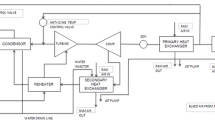Abstract
A model was developed of transient changes in metabolic heat production and core temperature for humans subjected to cold conditions. It was modified to predict thermal effects of the upper parts of the body being sprayed with water from a system designed to reduce the smoke effects of an airplane fire. Temperature changes were computed at 25 body segments in response to water immersion, cold-air exposure, and windy conditions. Inputs to the temperature controller were:(a) temperature change signals from skin segments and (b) an integrated signal of the product of skin and head-core (hypothalamic) temperature changes. The controller stimulated changes in blood flow to skin and muscle and heat production by shivering. Two controller parameters were adjusted to obtain good predictions of temperature and heat-production experimental data in head-out, water-immersion immersion (0°–28°C) studies in humans. A water layer on the skin whose thickness decreased transiently due to evaporation was added to describe the effects of the water-spray system. Because the layer evaporated rapibly in a very cold and windy environment, its additional cooling effect over a 60-min exposure period was minimal. The largest additional decrease in rectal temperature due to the water-layer was <1°C, which was in normal conditions where total decreases were small.
Similar content being viewed by others
References
Boutelier, C., L. Bougues, and J. Timbal Experimental study of convective heat transfer coefficient for the human body in water.J. Appl. Physiol. 42:93–100, 1977.
Gagge, A. P., and R. R. Gonzales Mechanisms of heat exchange: biophysics and physiology. In: Section 4: Environmental physiology, edited by M.J. Fregly and C.M. Blatties. New York: Oxford University Press, 1996, pp. 45–84.
Gagge, A. P., and Y. Nishi Heat exchange between human skin surface and thermal enviornment. In: Handbook of physiology. Adaptation to the environment, edited by D.H.K. Lee. Bethesda, MD: American Physiological Society 1977, pp. 69–92.
Gordon, R. G., R. B. Roemer, and S. M. Horvath A mathematical model of the human temperature regulatory system—transient cold exposure response.IEEE Trans. Biomed. Eng. BME-23:434–444, 1976.
Haslam, R. A., and K. C. Parsons Quantifying the effects of clothing for models of human response to the thermal environments.Ergonomics 31:1787–1806, 1988.
Haslam, R. A., and K. C. Parsons Using computer-based models for predicting human thermal responses to hot and cold environments.Ergonomics 37:399–416, 1994.
Hayward, J. S., and J. D. Eckerson. Physiological responses and survival time prediction for humans in ice-water.Aviat. Space Environ. Med. 55:206–212, 1984.
Hayward, J. S., J. D. Eckerson, and M. L. Collis. Thermoregulatory heat production in man: predication equation based on skin and core temperatures.J. Appl. Physiol. 42:377–384. 1977.
Hill, R. G., C. P. Sarkos, and T. R. Marker. Development and evaluation of an onboard aircraft cabin water spray system for postcrash fire protection. SAE No. 912224: 1991.
Holman, J. P. Heat transfer (second edition). New York: McGraw-Hill, 1968.
Jessen, C. Thermal afferents in the control of body temperature. In: Thermoregulation: physiology and biochemistry, edited by E. Schonbaum and P. Lomax. New York: Pergamon Press, 1990, pp. 153–183.
McArdle, W. D., J. R. Magel, T. J. Gergly, R. J. Spina, and M. M. Toner Thermal adjustment to cold-water exposure in resting men and women.J. Appl. Physiol. 56:1565–1571, 1984.
Montgomery, L. D. A model of heat transfer in immersed man.Ann. Biomed. Eng. 2:19–46, 1974.
Nadel, E. R., S. M. Horvath, C. A. Dawson, and A. Tucker. Sensitivity to central and peripheral thermal stimulation in man.J. Appl. Physiol. 29:603–609, 1970.
Raven, P. R., and S. M. Horvath. Variability of physiological parameters of unacclimatized males during a two-hourcold stress, 5°C.Int. J. Biometerol. 14:309–320, 1970.
Shender, B. S., J. W. Kaufman, and R. Ilmarinen Cold water immersion simulations using the Wissler Texas thermal model: validation and sensitivity analysis.Aviat. Space Environ. Med. 66:678–686, 1995.
Stolwijk, J. A. J., and J. D. Hardy. Control of body temperature. In: Handbook of physiology, Reaction to environmental agents, edited by D. H. K. Lee. Bethesda, MD: American Physiological Society, 1977, pp. 45–67.
Tikuisis, P., D. G. Bell, and I. Jacobs Shivering onset metabolic response, and convective heat transfer during cold airposure.J. Appl. Physiol. 70:1996–2002, 1991.
Tikuisis, P., R. R. Gonzales, and K. b. Pandolf Thermoregulatory model for immersion of humans in cold water.J. Appl. Physiol. 64:719–727, 1988.
Tikuisis, P., R. R. Gonzales, and K. B. Pandolf Prediction of human thermoregulatory responses and endurance time in water at 20 and 24°C.Aviat. Space Environ. Med. 59:742–748, 1988.
Tikuisis, P., R. R. Gonzales, and K. P. Pandolf Human ther-moregulatory model for whole body immersion in water at 20 and 28°C.US Army Res. Inst. Environ. Med. T23-87: 1–46, 1987.
Weast, R. C. Handbook of Chemistry and Physics (61st edition). Boca Raton, FL: CRC Press, 1980.
Wissler, E. H., Comparison of computed results obtained from two mathematical models—a simple 14-node model and a complex 250-node modell.J. Physiol. 63:455–458, 1971.
Wissler, E. H. Mathematical simulation of human thermal behavior using whole body models. Heat transfer in medicine and biology, edited by A. Shitzer and R. C. Eberhart New York: Plenum, 1985, pp. 325–373.
Author information
Authors and Affiliations
Rights and permissions
About this article
Cite this article
Wolf, M.B., Garner, R.P. Simulation of human thermoregulation during water immersion: Application to an aircraft cabin water-spray-system. Ann Biomed Eng 25, 620–634 (1997). https://doi.org/10.1007/BF02684840
Received:
Revised:
Accepted:
Issue Date:
DOI: https://doi.org/10.1007/BF02684840




